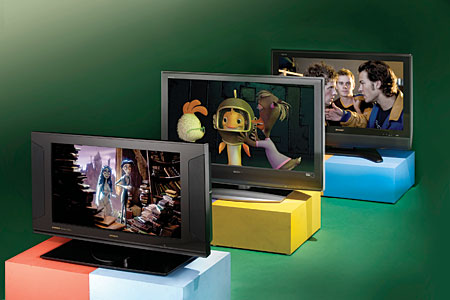HT's Inaugural LCD Face Off
LCD is coming into its own as a home theater technology, priming itself to challenge plasma and DLP in the larger screen sizes. Until recently, technology and size limitations have caused us to approach LCD as a second-room technology, but you can't ignore the roar of the masses, who are buying more LCD TVs than ever before, especially in the 32- to 42-inch screen sizes.

Rather than focus on a certain screen size for this Face Off, I decided to select products based on price, since that's still one of the primary issues with larger-screen LCDs. What can $3,000 to $3,500 get you in an LCD? If you want to stick with the big names in the business, it can get you a new 37-inch Sharp, 40-inch Sony, or 32-inch Hitachi—all HDTVs with built-in tuners and HDMI connectivity. In all fairness, it can get you a 37-inch Hitachi (the 37HDL52), but we chose to include the higher-end 32HLX61 because it utilizes Hitachi's new Advanced Super In-Plane Switching (AS-IPS) technology.
As video editor Geoffrey Morrison pointed out during this Face Off, you can get a similarly sized (or larger) plasma for less money than you'd spend on any of the LCDs in this test. True, but LCDs are making progress.
Logistically Speaking
This turned out to be quite the tricky Face Off, as the three TVs were, in many respects, more similar than different. We evaluated the TVs before and after calibration using the demo scenes listed in the sidebar at the end. Color, film processing, and dynamic range were fairly close between the three. During the setup process, I spent an entire afternoon comparing the TVs using my arsenal of demo discs, yet I walked away uncertain as to which one I would rank number one. So, I sympathize with our three panelists—Geoffrey, copy editor Nikhil Burman, and contributor John Higgins—who had less time and fewer test scenes at their disposal to make a decision.
I wish I could say that similarity meant great performance across the board, but it didn't. If anything, we got satisfactory performance across the board, with each TV coming up short in a critical area, be it detail, black level, or viewing angle.
The one thing all LCDs have in common is light output—as in, they've got some to spare. LCDs are seldom described as dark, medium, or bright, but instead as bright, really bright, or freakishly bright. All three TVs in this test have an adjustable backlight that lets you adjust brightness or black level to suit your room. This gives each TV a number of brightness and black levels to choose from. So, to level the playing field, we decided to match the light output of all three TVs and evaluate everything else around that constant. At the end, we looked at each TV at its maximum and minimum backlight settings to check out its full capabilities.
- Log in or register to post comments



































































